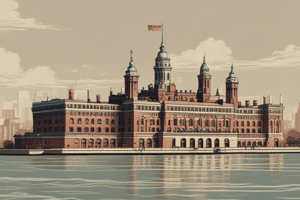Podcast
Questions and Answers
What was an important pull factor that drew European immigrants to the United States after the Civil War?
What was an important pull factor that drew European immigrants to the United States after the Civil War?
The idea of life in a free and democratic society
What push factors caused immigrants to leave Europe? (Select all that apply)
What push factors caused immigrants to leave Europe? (Select all that apply)
- Population growth (correct)
- Scarcity of arable land (correct)
- Religious persecution (correct)
- Hunger (correct)
Describe the experience for immigrants living in steerage.
Describe the experience for immigrants living in steerage.
Immigrants slept in huge rooms on metal bunks and suffered through seasickness, spoiled food, and filthy toilets.
Upon arriving by ship in New York Harbor, who was required to go through immigration inspections at Ellis Island?
Upon arriving by ship in New York Harbor, who was required to go through immigration inspections at Ellis Island?
Describe the experience of most immigrants going through Ellis Island.
Describe the experience of most immigrants going through Ellis Island.
Describe the life in the United States for European immigrants.
Describe the life in the United States for European immigrants.
What was the difference between immigrant aid societies and settlement houses?
What was the difference between immigrant aid societies and settlement houses?
What was a political boss?
What was a political boss?
Which group passed laws to decrease the number of immigrants coming to America?
Which group passed laws to decrease the number of immigrants coming to America?
Describe Chinese immigration.
Describe Chinese immigration.
Why did Congress make it illegal for U.S. employers to hire contract laborers?
Why did Congress make it illegal for U.S. employers to hire contract laborers?
Describe the experience of immigrants landing at Angel Island.
Describe the experience of immigrants landing at Angel Island.
Flashcards
Pull Factors
Pull Factors
Freedom and democracy in the U.S. attracted European immigrants post-Civil War.
Push Factors
Push Factors
Population growth, hunger, limited land, religious persecution, and enticing stories drove Europeans to leave.
Steerage
Steerage
The lower deck of ships, with cramped, unsanitary conditions for immigrants.
Ellis Island inspections
Ellis Island inspections
Signup and view all the flashcards
Immigrant aid societies
Immigrant aid societies
Signup and view all the flashcards
Settlement Houses
Settlement Houses
Signup and view all the flashcards
Political bosses
Political bosses
Signup and view all the flashcards
Immigration Restriction League
Immigration Restriction League
Signup and view all the flashcards
Chinese Exclusion Act
Chinese Exclusion Act
Signup and view all the flashcards
Angel Island
Angel Island
Signup and view all the flashcards
Foran Act
Foran Act
Signup and view all the flashcards
Study Notes
Pull Factors for Immigration
- The promise of freedom and democracy was a significant pull factor attracting European immigrants to the U.S. post-Civil War.
Push Factors for Leaving Europe
- Population growth and widespread hunger were primary reasons driving Europeans to emigrate.
- Limited arable land presented a challenge for agricultural sustainability.
- Religious persecution forced many to flee their homelands.
- Exaggerated accounts of American life circulated back home, enticing further emigration.
Steerage Experience
- Immigrants unable to afford cabins traveled in steerage, the lower deck area of ships.
- Conditions in steerage were harsh, featuring cramped rooms, metal bunks, seasickness, spoiled food, and unsanitary toilets.
Immigration Inspections at Ellis Island
- Steerage passengers underwent thorough immigration inspections upon arrival at Ellis Island.
- First and second-class passengers faced brief examinations on the ship before disembarking.
Ellis Island Experiences
- Immigrants experienced medical and legal examinations; those failing could be deported.
- Medical treatment was provided for conditions, allowing some to enter the U.S.
- The Foran Act prohibited employers from importing foreign labor to replace striking workers.
Life in the United States for Immigrants
- Many European immigrants settled in urban areas near job opportunities.
- They often lived in low-quality housing close to their ethnic communities.
Immigrant Aid Societies vs. Settlement Houses
- Immigrant aid societies were ethnic organizations that provided community support, typically by collecting donations.
- Settlement houses served as community centers offering essential services like child care, education, and health clinics to immigrants and the poor.
Political Bosses
- Political bosses offered jobs and social services to immigrants in exchange for electoral support, fostering mutual benefits.
Nativist Actions Against Immigration
- Organizations like the Immigration Restriction League sought to limit immigration through measures like literacy tests.
- In the 1920s, Congress enacted quotas to restrict European immigration, reflecting fears over cultural and religious differences.
Chinese Immigration Trends
- Chinese immigrants, predominantly male, entered the U.S. through San Francisco, seeking work on farms after laboring on plantations in Hawaii.
- They often filled lower-paying jobs due to employers’ preferences for cheaper labor.
Legislative Actions Against Chinese Labor
- The Chinese Exclusion Act prohibited Chinese laborer immigration for ten years and blocked current Chinese immigrants from citizenship, marking a historic racial immigration restriction.
Experience at Angel Island
- Angel Island served as an enforcement point for the Chinese Exclusion Act, isolating immigrants from family support and resembling the inspection process at Ellis Island.
Studying That Suits You
Use AI to generate personalized quizzes and flashcards to suit your learning preferences.




